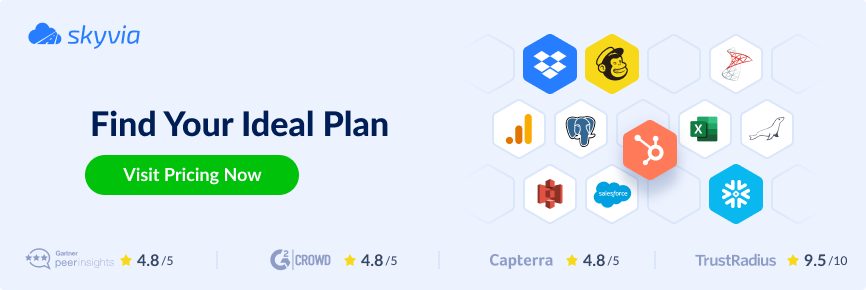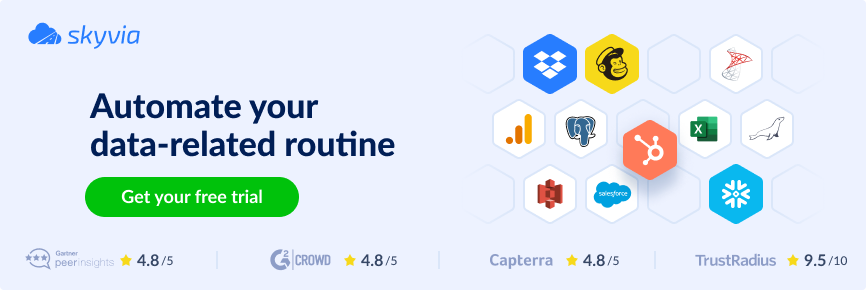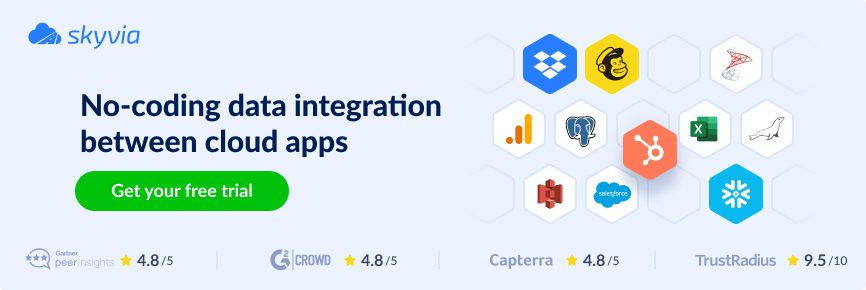ETL tools are integral to the modern data infrastructures in SMBs and enterprises. However, many companies find allocating a budget for those solutions challenging.
The main difficulty in estimating spending for ETL services is the unpredictability of data amounts and complex pricing models. This article disaggregates popular ETL pricing models to help you resolve the ETL cost puzzle. You’ll also discover which factors impact the overall cost and find the prices for popular data integration services.
Table of Contents
- How Does ETL Pricing Work?
- Most Popular Pricing Models Among ETL Solutions
- Factors Influencing the Cost of ETL Tools
- Leading ETL Tools Cost
- ETL Tools Price Comparison
- Pricing of ETL Solutions: What to Expect?
- Summary
How Does ETL Pricing Work?
When you go to the market, you buy a bottle of milk for a fixed price, which slightly ranges for different vendors. Simple, right? Things become more complicated for technical devices, such as an espresso machine, where the price depends on the selected item’s technical characteristics, color, and additional features.
Though buying ETL software has much in common with buying an espresso machine, the pricing is even more dynamic. Modern ETL tools are usually cloud-based, so they inherit the concepts of major cloud providers for product cost. The features, as well as the intensity of usage in data volume and the number of people exploiting the tool, determine the price.
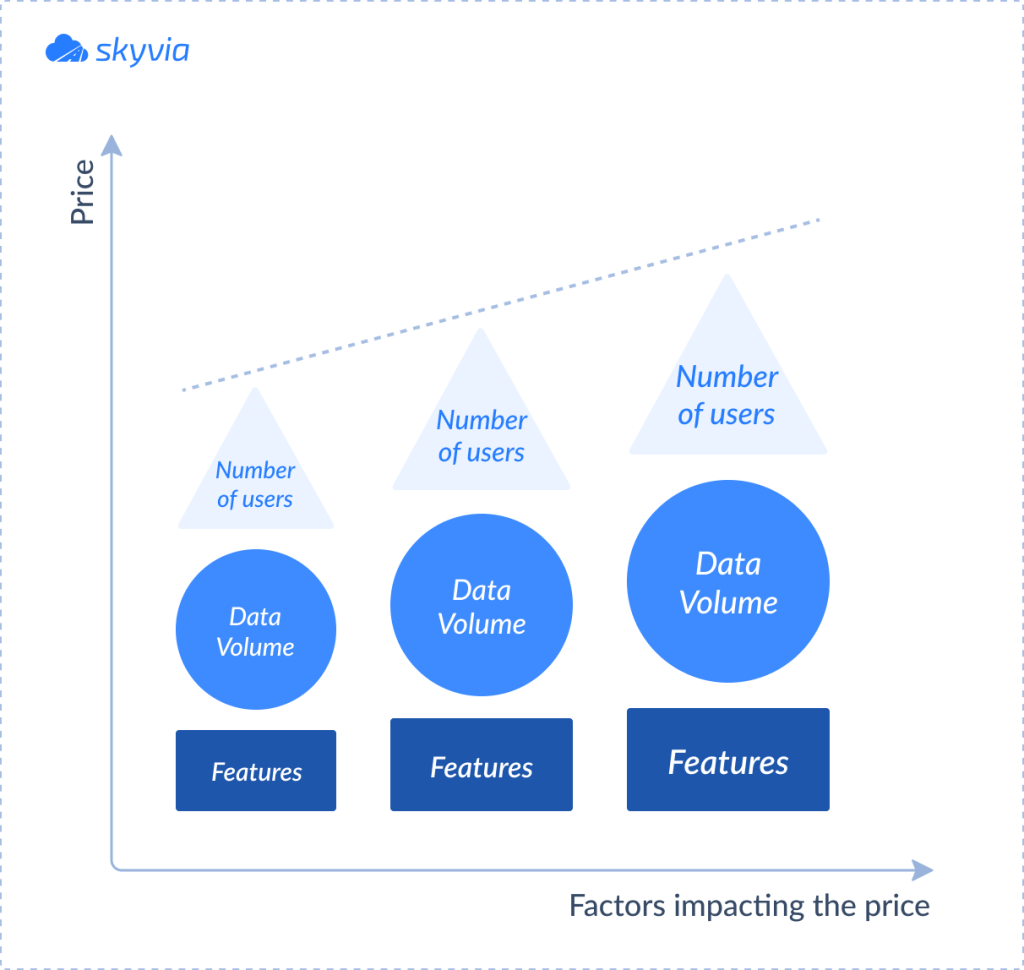
Most Popular Pricing Models Among ETL Solutions
Usage-Based or Pay-As-You-Go Model
The total cost for ETL services under the pay-as-you-go model is revealed at the end of the billing period. This is similar to electricity or water consumption, with bills arriving at the end of the month. The pay-as-you-go concept is rather flexible and gives businesses unlimited resources. However, it imposes risks on budget planning due to unpredictable data volumes to process.
Subscription-Based Pricing
This is probably the most popular pricing model since it’s predictable for producers and consumers. It’s like a Netflix subscription, where the monthly payment depends on the number of users, video quality, and supported devices.
The subscription-based model is also known as a tiered subscription model. Each level includes features and options available at the corresponding cost.
User-Based Pricing
This model is fundamental for Salesforce or Zendesk apps, where the number of active users is a decisive factor in the overall software price. Some ETL tools also rely on user-based pricing but in conjunction with a pay-as-you-go or subscription model.
Flat-Rate Model
This approach is as old as the IT industry, but it’s still used for ETL and other cloud-based software. The flat-rate model establishes the unique price for the product, disregarding the number of features, users, and other characteristics.
Freemium Model
The freemium model is usually the first tier of a subscription model. It aims to acquaint consumers with the software and convert them to paid customers. As a rule, freemium plans only have basic features and usually set limits on data volume, user number, connectors, etc.
Note that a freemium model is NOT the same as a free trial. Even though both options are free for users, the freemium tier isn’t limited in time, while a free trial usually lasts up to 30 days. Moreover, a free trial has all the features available for the requested software. If an ETL provider offers four subscription tiers, there will be four different types of free trials.
Factors Influencing the Cost of ETL Tools
Usage-based and subscription-based models are common for ETL software. Now, let’s explore the factors influencing the cost of ETL tools.
Data Volume
Data amount is like Zeus, the god of all gods, on Olympus. It’s the most powerful factor shaping the total ETL cost. The more data rows flow in your data pipelines, the more you’ll have to pay.
With the pay-as-you-go model, the price depends on the amount of data rows processed during the billing cycle. In the subscription-based model, each plan indicates the maximum number of data rows for processing at the corresponding price.
Connectors
ETL tools generally include pre-built connectors for popular apps, databases, and data warehouses. In the subscription-based tiered model, the availability of connectors ranges depending on the plan.
Some ETL solutions allow users to create custom connectors for added price. This option facilitates integration from legacy systems, niche apps, newly developed tools, etc.
Data Update Frequency
Most ETL tools use batch data processing to collect and update data regularly on a schedule. The update intervals usually range between one month and one minute. The more frequent updates are needed, the higher the cost of the ETL tool.
Some ETL platforms offer real-time data processing, but it’s much more complex than the batch approach. It relies on real-time transport protocol, large data volumes in disposal, and complex infrastructure. Consequently, the ETL tools with real-time data processing may cost an arm and a leg.
Functionality
The ETL concept isn’t limited to data extraction from a single source and loading it into another, with transformations in between. Modern tools offer complex ETL pipeline design with several sources/destinations, compound data mapping, transformations, advanced features, etc. As a rule, the larger the feature set is, the higher the ETL cost.
Support
Most ETL solutions include basic support features for their products. Some ETL providers also offer premium or platinum support as an add-on. This usually implies 24/7 support, onboarding sessions, and other exclusive services helping businesses implement, maintain, and effectively use the ETL tool.
Leading ETL Tools Cost
To better understand the pricing for ETL solutions, let’s examine the most popular tools in the industry.
Skyvia
Skyvia is a universal cloud data platform designed for a wide set of data-related tasks. It contains five principal products: Data Integration, Query, Connect, Automation, and Backup. Each of them relies on the tiered subscription model with the possibility of monthly or yearly subscription.
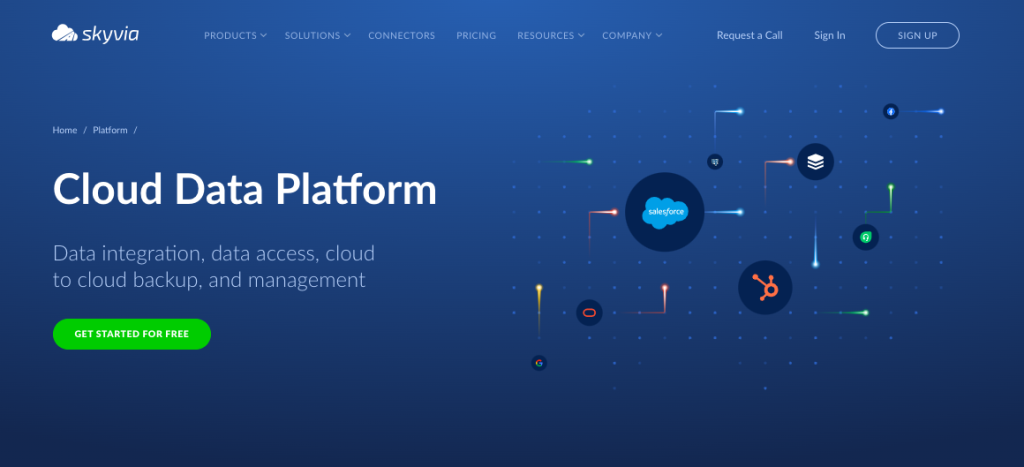
Let’s examine the pricing model of Skyvia’s Data Integration product with five plans available. The price for each depends on the following factors:
- Records per month (data volume)
- Scheduling frequency
- Number of scheduled integrations
- Available integration scenarios
- Available data mapping and transformation options
Below, find the table with four pricing plans and the options available for each. The fifth plan, called Enterprise, offers a tailor-made solution with advanced security features and premium support. To get all the details about the Enterprise plan, feel free to contact [email protected].
| Free | Basic | Standard | Professional | |
| Records per month | 10k max | 5M-200M | 500k-200M | 5M-200M |
| Scheduling frequency | once a day | once an hour | once a minute | |
| Scheduled integrations | 2 | 5 | 50 | unlimited |
| Import | Available with all DML operations, binary file import, target lookup mapping. | Includes features available in the Basic plan, source lookup mapping, expression mapping, CSV file mask, relation mapping, data splitting, returning. | ||
| Export | Available | Includes advanced source mode available additionally | ||
| Replication | Available | |||
| Synchronization | Includes target lookup mapping as an additional feature | Includes target lookup mapping, source lookup mapping, expression mapping, relation mapping, data splitting | ||
| Data Flow | Not available | Available | ||
| Control Flow | Not available | Available | ||
| Pricing | $0 | starts from $79/month | starts from $79/month | starts from $199/month |
Fivetran
Fivetran is another popular tool for designing and running ETL pipelines. It’s also known as a modern data movement platform.
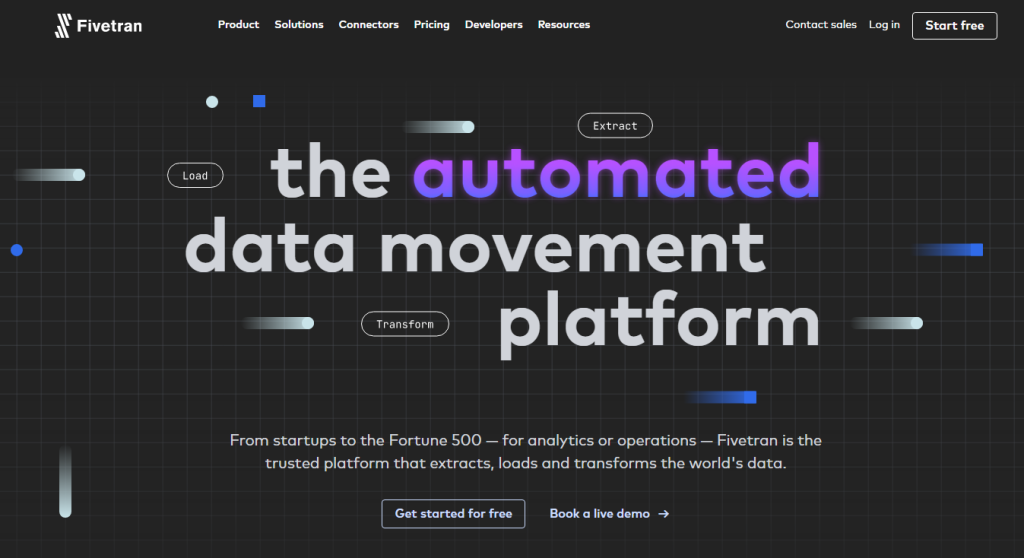
Its pricing model is very similar to that of Skyvia. However, Fivetran adds more variables to the equation for cost calculation. Apart from data volume and available features, it considers users and connectors.
The Starter, Standard, and Enterprise plans have no exact data volume limitations. The cost depends on the number of monthly active rows (MAR) and the spend rate. The spend rate is a flexible parameter that considers the correlation between the total number of rows, the MARs you use, and the pricing plan you are on. Fivetran’s official website has a pricing calculator that considers all these parameters.
| Free | Starter | Standard | Enterprise | |
| Monthly active rows (MAR) | Up to 500,000 | Total Monthly Cost = MARs x Spend Rate | ||
| Scheduling frequency | once an hour | every 15 min | once a minute | |
| Users | max 10 | unlimited | ||
| Connectors | 500+ managed connectors | Starter plan connectors + database connectors | Standard plan connectors + enterprise database connectors | |
| Extra features | Automatic schema migrations, integration for dbt Core | Access to Fivetran’s REST API | Advanced data governance, security, and resilience options; priority support | |
There’s also an extended enterprise plan called Business Critical with custom pricing. It has advanced security features, such as private networking options, access to Fivetran HVR, and customer-managed encryption keys.
The Fivetran pricing model is rather complicated as it considers multiple factors. The price for each case is calculated individually, so there are no approximate numbers for Fivetran usage.
Airbyte
Airbyte offers several solutions, including the extract-load service. In fact, it’s an open-source platform with 1,000+ contributors for data movement between diverse systems.
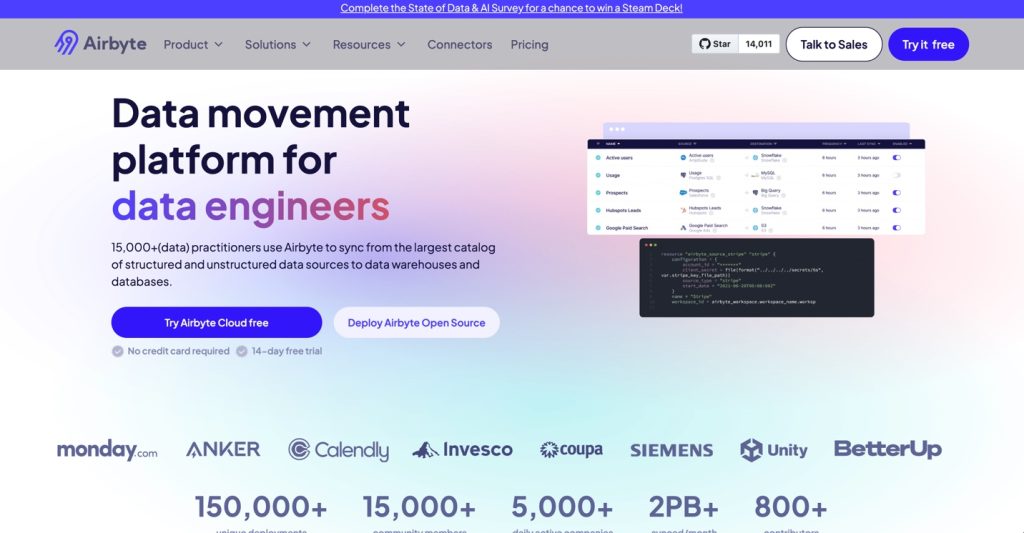
So, let’s shed light on Airbyte pricing options.
| Open Source | Cloud | Team | Enterprise | |
| Hosting | Self-hosted | Hosted on Airbyte cloud | Self-hosted | |
| Connectors | 300+ sources and destinations + low-code connector builder | Open source connectors + custom connectors | Open source connectors + enterprise connectors | |
| Support | Slack community channel | Email alerts and support | Onboarding, emails, premier support | Onboarding, emails, enterprise support |
| Sync frequency | Once an hour | Custom intervals | ||
| Security standard compliance | – | SOC 2, GDPR, ISO, HIPAA Conduit | ||
| Extra security features | – | – | Role-based access control (RBAC), SSO/SAML/SCIM provisioning | |
The open-source variant is ideal for tech-savvy professionals ready to deploy Airbyte on their private clouds. In this case, organizations implementing open-source solutions are responsible for all the security-related procedures to guarantee data safety during transport.
The price for other plans is discussed with Airbyte’s Sales team. Paid packages grant support, alerting, extra security features, and custom sync intervals as additional add-ons to the open-source base.
Hevo
Hevo provides a SaaS solution for automating data pipelines. Its pricing model relies on tiered subscriptions, similar to those used in Skyvia and Fivetran companies.
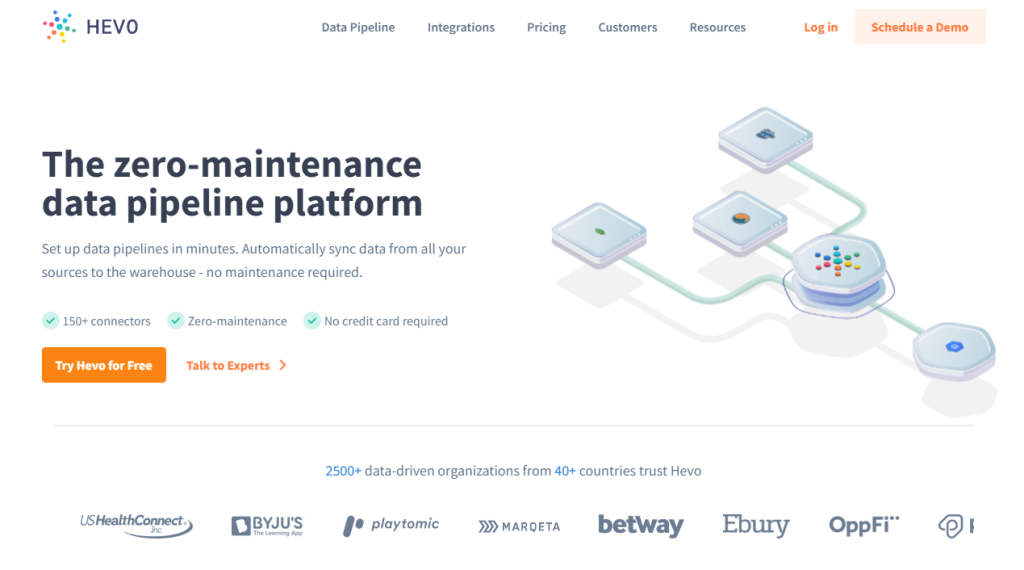
| Free | Starter | Professional | |
| Data volume in events | Up to 1 M | 5-50 M | 20-100 M |
| Users | Up to 5 | Up to 10 | Unlimited |
| Scheduling frequency | Once an hour | Once an hour | Real-time |
| Connectors | around 70 | 150+ | |
| dbt integration | – | Available | |
| Security | SOC 2 Type II | SOC 2 Type II, SSL encryption, SSH tunnels for encryption | |
| Support | Email support | Email and live chat support | |
| Price | $0 | starts from $239/month | starts from $679/month |
Organizations craving more complex ETL solutions might consider the Business Critical plan. It has multiple workspaces, offers advanced security features, and grants other custom features on-demand.
Stitch
Stitch is an ETL service that moves data between different sources, including databases and cloud applications. Unlike the above-mentioned tools, it doesn’t offer any free plan but offers a trial for each plan.

Stitch’s pricing model is also based on the tiered subscription approach. Data volume is the core factor determining the payment for Stitch solution. Sources and destinations, users, and support options are among other critical factors impacting the overall cost of the ETL service.
| Standard | Advanced | Premium | |
| Data volume in rows per month | 5-300 M | 100 M | 1 billion |
| Users | Up to 5 | Unlimited | |
| Destinations | 1 | 3 | 5 |
| Sources | 10 | Unlimited (enterprise sources) | |
| Log retention | 7 days | 60 days | |
| Support | Chat, portal | Gold package | Premium package |
| Price | starts from $100/month | starts from $1250/month, billed annually | starts from $2500/month, billed annually |
ETL Tools Price Comparison
Now, it’s time to recall the factors influencing the ETL cost. Previously, we have mentioned the five core components shaping the overall product price for ETL solutions.
Data volume comes as the main factor by default, so it’s not included in the table. As all the above-mentioned solutions use batch processing for data on all predefined tiers, this factor isn’t mentioned as well. Meanwhile, users, connectors, and support factors do impact the ETL costs. Feel free to explore the table below to see how they define the pricing.
Free pricing tier | Starting price | Factors impacting price | |||
| Users | Connectors | Support | |||
| Skyvia | Yes | $79 | No | No | No |
| Fivetran | Yes | Contact sales | Yes | Yes | Yes |
| Airbyte | Yes | Contact sales | No | Yes | Yes |
| Hevo | Yes | $279 | Yes | Yes | Yes |
| Stitch | No | $100 | Yes | Yes | Yes |
Compared to other ETL tools, Skyvia’s price doesn’t depend on users, connectors, or support options. Even users on the basic plan have all the pre-built connectors at their disposal and can contact the Skyvia team via all support channels. It also doesn’t matter how big your data team and organization are; everything depends on the data volume you need to operate.
Pricing of ETL Solutions: What to Expect?
When considering the future of ETL pricing, it’s worth exploring the data integration trends first. By understanding these tendencies, it becomes possible to forecast something related to ETL cost.
- Switching from ETL to ELT. The trend for ELT (extract-transform-load) has prevailed for the last several years. It speeds up the data transfer as the transformations are performed on the target side. Moreover, ELT supports unstructured data, which is now very common online. Note that Skyvia already supports the design of both ETL and ELT pipelines. The price for ELT solutions will most likely depend on the data volume and scheduling frequency.
- Real-time processing. Even though batch processing is still widely used, real-time data is gaining momentum. Monitoring systems, fraud detection mechanisms, transport systems, etc., rely on real-time data processing. Probably, the tools supporting real-time data processing will likely be costly.
- Growing number of apps. Given that big data tools and new SaaS solutions emerge, ETL and ELT tools will have to support the most popular of them. We’ve already proven that connectors impact the cost of ETL tools. Solutions with many supported connectors or the possibility of adding new ones will likely be a daylight robbery.
- Data security. The price of tools explored in this article grows with added security features. As online data security importance is obvious, companies would likely invest in protective mechanisms.
Summary
ETL tools are important for businesses that value data-driven insights. Thus, allocating a budget for such services is crucial.
Most ETL services are based on the tiered subscription model, where the price for each software level depends on the following:
- users,
- connectors,
- support options,
- real-time processing,
- mapping features, etc.
Some ETL tools also offer free trials for different plans, which is great for those who want to test everything before investing in data integration infrastructure.
Skyvia is an ETL tool offering a freemium tier as well as free trial for each paid plan, so feel free to test it now!
